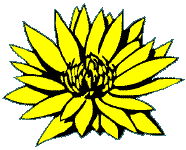
A basic requirement for water lilies is sunlight. More sun, more blooms, less sun, less blooms. At least half a day of sunshine will give reasonably good results.
Water lilies are correctly known as Nymphaea, a genus of herbaceous aquatics hailing from almost every part of the world. These, and the colourful hybrids developed from them, may be divided into two groups - hardy and tropicals.

Hardy water lilies flower on the water surface and will survive even severe frosts, providing the rhizome is planted at least 25cm below the surface of the water.
Tropical water lilies send up blooms on stems above the water, and require warmer conditions.
A single hardy water lily rhizome will develop into a well-filled circle of leaves approximately 76cm or more across, under good conditions in a single year. This amount of growth should be allowed per plant in the planning stage, still leaving enough water surface space for reflections and the welfare of fish, which must have some light.
All care should be taken when spraying garden plants that no spray drifts into ponds containing fish.
After the simple initial planting, water lilies require no attention for two years.
They come in a wide variety of colours, from vivid reds through shades of cyclamen and pink, to palest blush and so to white. There are also shades of lemon, yellow and apricot.
Flowering time depends on the warmth of the water. In the southern states it is normally from November until late March, while in northern areas the blooming period is longer. A sturdy rhizome planted just prior to the flowering season could produce blooms in 5 - 6 weeks, providing weather conditions are favourable. It is possible for a new plant to produce up to 40 or more blooms during the first season.
Water lily rhizomes may be planted at any time of the year, however the leaves of lilies planted during the flowering time usually die off and new ones will soon grow. Rhizomes planted in cold weather will remain dormant until warmth stimulates growth.
Hardy water lilies need a depth of 36 cm to 46 cm or more of water to produce strong blooms. Do not over-plant. Where space permits, allow ½ to 1 square metre of water surface for each plant.
The ideal and practical way to plant water lilies is in strong, plastic containers approximately 30 cm diameter x 12 cm deep. It is a simple task then to lift these containers for dividing every two years.
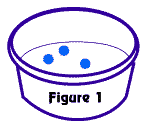
Another advantage is that you can have different varieties in a pond and have no problem of inter-mixing of roots, so when sub-dividing there is no risk of losing a variety. Water lilies spread their roots laterally and the containers properly prepared will provide ideal and adequate conditions for each rhizome.
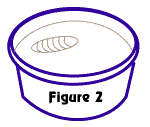
Water lilies are gross feeders and benefit from access to fertiliser. Place (see figure 1) 3 x 10 gram slow release fertiliser tablets in the bottom of the container then fill to within one inch of the top with good garden soil (slightly damp for compacting), of a clay rather than sandy texture.
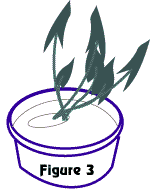
Make a depression in the soil, just back from the centre as shown in figure 2, to accommodate the rhizome. Water lilies grow and spread their roots laterally, hence the need for a wide, shallow bowl for planting.
Place the rhizome into the depression in the soil and tamp the soil down hard,
being careful not to damage the growing crown of the rhizome. See figure 3
Note: Be sure to plant only one rhizome per bowl.
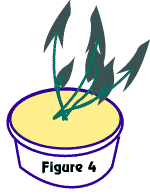
Fill the container to the brim with (approximately 25 mm) with a layer of washed sand or fine screenings. This helps to prevent the leaching of nutriment into the water, thus avoiding discolouration of the pond water and excessive algae growth. See figure 4
Within a few weeks of first filling the pond, the water may become green or murky, but don't worry. As the water lilies and oxygenating plants grow and scavengers (such as snails and fish) fulfil their role, the water should clear up all by itself.
Plants and fish like mature water, therefore do not unnecessarily empty and re-fill the pond. Rain will usually take care of evaporation. However, if you need to top up the pond, do so from a gently flowing hose. If the water becomes discoloured later, allow a hose to trickle slowly into the pond and let it over-flow. This should help clear the water.
Just sun, water, plants and scavengers. Get them in their right balance and that's that. No watering, no weeding -- and no trouble in finding time to admire the result.
To obtain a pool with sparkling clarity, the balance of nature must be introduced.
Oxygenating plants are essential; Vallisneria and Elodea being two of the best. Other water plants are helpful for decorative purposes, spawning and protection of fish ie. Parrots Feather. Water lettuce is another interesting floating water plant, with fibrous roots, ideal for spawning.
Goldfish are a most useful and attractive addition to any pond as they prevent the breeding of mosquitoes and other insect life and also eliminate Caddis Fly larvae, which attack the water lilies.
Water snails are also important as they are scavengers and help to clean up the rotting vegetation and algae that grows on water plants.
Note: All Gedye fibreglass ponds are of the correct depth to give ideal conditions for water lilies, plants and ornamental fish. A garden pond, which is too shallow, is useless and will only give disappointing results.
Another advantage of fibreglass ponds is that they need no treatment or curing, so water lilies, plants and fish can all be placed into the pond immediately. However, if the pond is new concrete or asbestos cement it should be painted with a Chlorinated rubber paint to seal off the lime, which is fatal to fish and detrimental to plants. This paint is available from our Nursery.